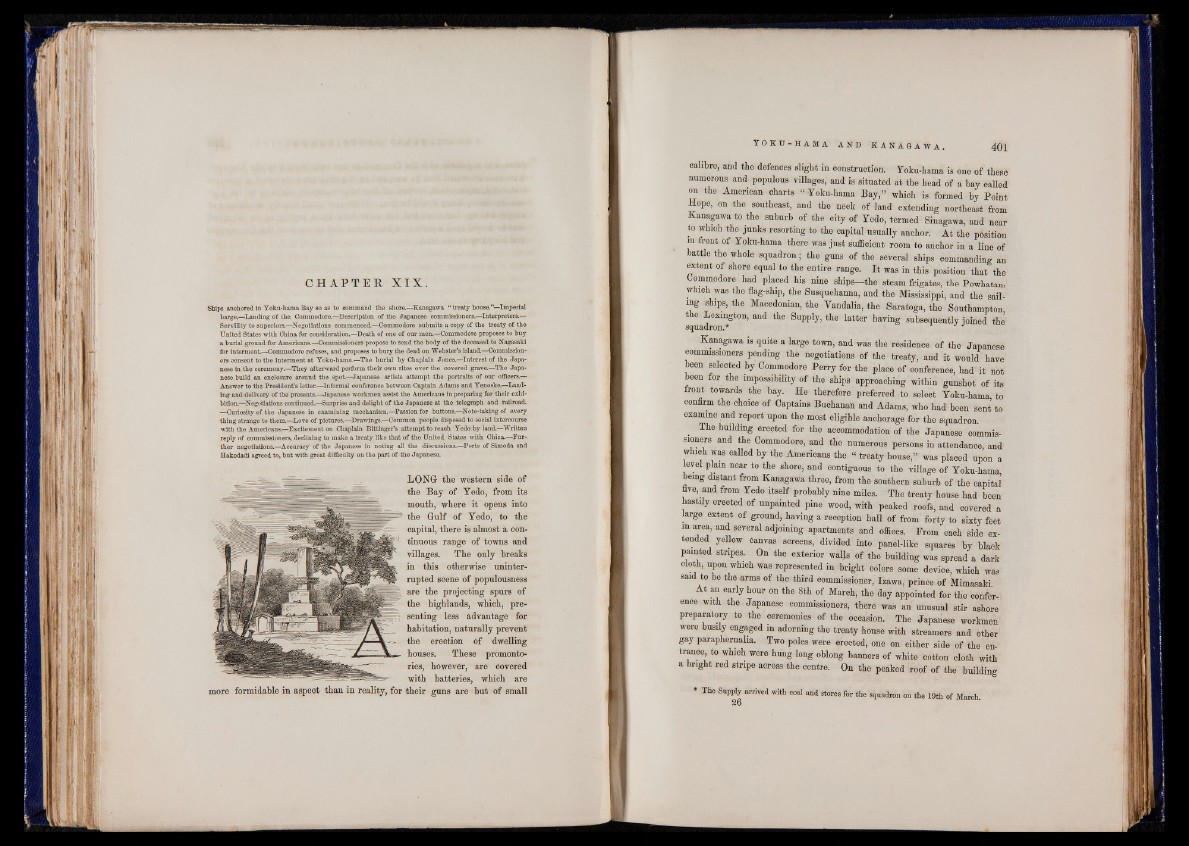
CHAPTER XIX.
Ships anchored in Yoku-hama Bay so as to command the shore.—Kanagawa “ treaty house.”—Imperial
targe.—Handing o f the Commodore.—Description of the Japanese commissioners.—Interpreters.—
Servility to superiors.—Negotiations commenced.—Commodore submits a copy of the treaty of the
United States w ith China for consideration.—Death of one of our men.—Commodore proposes to buy
a burial ground fbr Americans.—Commissioners propose to send the body of the deceased to Nagasaki
for interment.—Commodore refuses, and proposes to bury the dead on Webster’s island.—Commissioners
consent to the interment at Yoku-hama.—The burial by Chaplain Jones.—Interest of the Japanese
in the ceremony.—They afterward perform their own rites over the covered grave.—The Japanese
build an enclosure around the spot.—Japanese artists attempt the portraits of our officers.—
Answer to the President’s letter.—Informal conference between Captain Adams and Yenoske.—Landing
and delivery of the presents.—Japanese workmen assist the Americans in preparing for their exhibition.—
Negotiations continued.—Surprise and delight o f the Japanese at the telegraph and railroad.
—Curiosity of the Japanese in examining mechanism.—-Passion for buttons.—Note-taking of every
thing strange to them.—Love of pictures.—Drawings.—Common people disposed to social intercourse
with the Americans.—Excitement on Chaplain Bittinger’s attempt to reach Yedobyland.—Written
reply of commissioners, declining to make a treaty like that of the United States with China.—F u r ther
negotiations.—Accuracy of the Japanese in noting all the discussions.—Ports of Simoda and
Hakodadi agreed to, but with great difficulty on the p art of the Japanese.
LONG the western side of
the Bay of Tedo, from its
mouth, where it opens into
the Gulf of Yedo, to the
capital, there is almost a con-
” tinuous range of towns and
villages. The only breaks
in this otherwise uninterrupted
scene of populousness
are the projecting spurs of
the highlands, which, presenting
less advantage for
habitation, naturally prevent
the erection of dwelling
houses. These promontories,
however, are covered
with batteries, which are
more formidable in aspect than in reality, for their guns are but of small
calibre, and the defences slight in construction. Yoku-hama is one of these
numerous and populous villages, and is situated at the head of a bay called
on the American charts “ Yoku-hama Bay,” which is formed by Point
Hope, on the southeast, and the neck of land extending northeast from
Kanagawa to the suburb of the city of Yedo, termed Sinagawa, and near
to which the junks resorting to the capital usually anchor. At the position
m front of Yoku-hama there was just sufficient room to anchor in a line of
battle the whole squadron; the guns of the several ships commanding an
extent of shore equal to the entire range. I t was in this position that the
Commodore had placed his nine ships—the steam frigates, the Powhatan,
which was the flag-ship, the Susquehanna, and the Mississippi, and the sailing
ships, the Macedonian, the Vandalia, the Saratoga, the Southampton,
the Lexington, and the Supply, the latter having subsequently joined the
squadron.* J
Kanagawa is quite a large town, and was the residence of the Japanese
commissioners pending the negotiations of the treaty, and it would have
been selected by Commodore Perry for the place of conference, had it not
been for the impossibility of the ships approaching within gunshot of its
front towards the bay. He therefore preferred to select Yoku-hama to
confirm the choice of Captains Buchanan and Adams, who had been sent to
examine and report upon the most eligible anchorage for the squadron.
The building erected for the accommodation of the Japanese commissioners
and the Commodore, and the numerous persons in attendance, and
which was called by the Americans the “ treaty house,” was placed upon a
evel plain near to the shore, and contiguous to the village of Yoku-hama
being distent from Kanagawa three, from the southern suburb of the capital’
five, and from Yedo itself probably nine miles. The treaty house had been
hastily erected of unpainted pine wood, with peaked roofs, and covered a
large extent of ground, having a reception hall of from forty to sixty feet
in area, and several adjoining apartments and offices. Prom each side extended
yellow canvas screens, divided into panel-like squares by black
painted stripes. On the exterior walls of the building was spread a dark
cloth upon which was represented in bright colors some device, which was
said to be the arms of the third commissioner, Izawa, prince of Mimasaki.
At an early hour on the 8th of March, the day appointed for the conference
with the Japanese commissioners, there was an unusual stir ashore
preparatory to the ceremonies of the occasion. The Japanese workmen
were busily engaged m adorning the treaty house with streamers and other
gay paraphernalia. Two poles were erected, one on either side of the entrance,
to which were hung long oblong banners of white cotton cloth with
a bright red stripe across the centre. On the peaked roof of the building
* The Supply arrived with coal and stores for the squadron on the 19th of March.